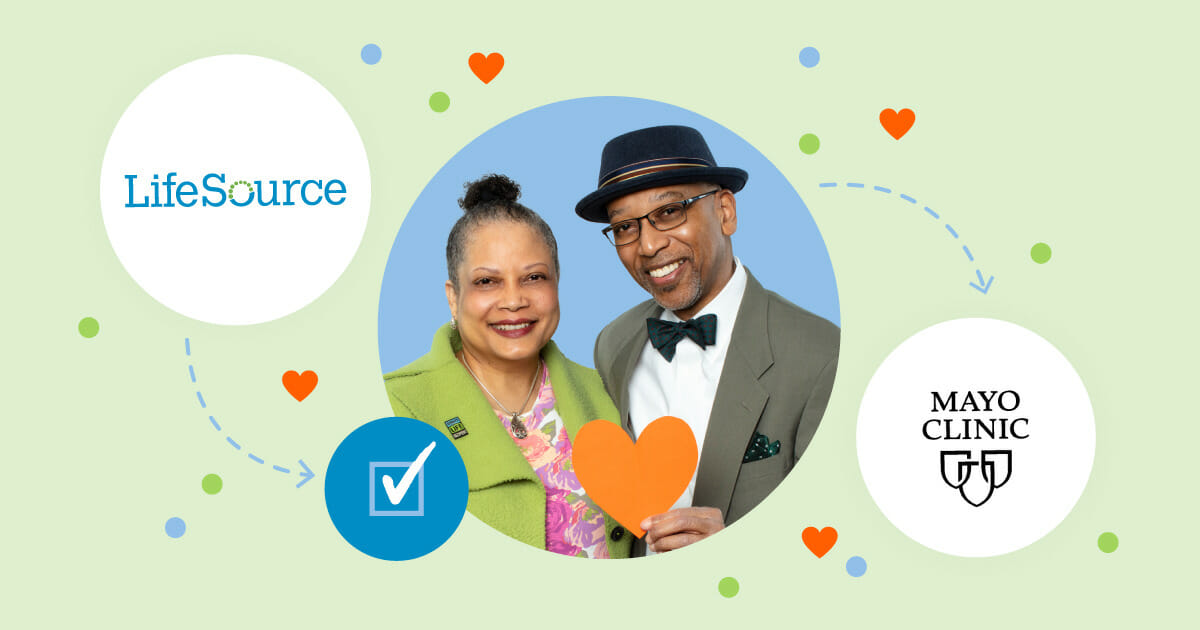How We Work Together to Save Lives Through Organ Donation and Transplantation

The organ donation process has been described as a complex symphony of collaborators working together, in a short time frame, to save and heal lives. Without collaboration from organizations like Mayo Clinic and the community, this life-saving work would not be possible.
Here are some common questions we receive about how organ donation works:
Who manages the process of organ donation?
Federally designated Organ Procurement Organizations (OPOs) are the bridge between donors and potential recipients. LifeSource is the OPO for Minnesota, North Dakota, South Dakota and western Wisconsin.
LifeSource uses the National Organ Procurement and Transplant Network (OPTN) Waiting List to identify transplant recipient matches. After donors are identified by a donor hospital – such as Mayo Clinic – LifeSource coordinates the recovery of organs with the donor’s family, transplant surgeons and donor hospital staff. LifeSource also works with funeral homes to coordinate the donor’s transfer in preparation for their service.
What is the difference between living and deceased donation?
Deceased Donation
For a person to become an organ donor, they need to pass away in a hospital and remain on ventilated support to give the gifts or organs, eye and tissue donation. This is known as deceased donation. LifeSource is the designated organization that can manage the process of organ donation after a person has passed away.
What can be donated?
- Organs: life-saving gifts include kidneys, liver, lungs, heart, pancreas and intestines and can save up to eight people.
- Tissue & Eyes: a deceased donor can also donate bone, tendons, heart valves, tissue, arteries and corneas. These important gifts can help with reconstructive surgery, repair cleft palates, repair sports injuries, treat burn victims, and complete mastectomy reconstruction.
How do I register as a donor?
- There are many quick ways to register as a donor: you can register online, check the “donor” box on your driver’s license, register when you get your hunting or fishing license or use the Health App on your iPhone.
Living Donation
Living donation takes place when a living person donates an organ (or part of an organ) for transplantation to another person. The living donor can be a family member, a friend or a stranger. An interested living donor works directly with a transplant center, like Mayo Clinic.
What can be donated?
- Living donors can donate a kidney or part of the liver, lung, intestine or pancreas to another person in need of a transplant. Learn more.
How do I register as a donor?
- If you’d like to become a living donor and wish to help somebody in need of a life-saving transplant, contact Mayo Clinic or another transplant center in your area.
What are the current needs for organ donation and registration in Minnesota?
There are currently 2,575 people in our community waiting for life-saving transplants in Minnesota; 2,111 of those people are waiting for kidneys.
While 70% of Minnesotans have already registered on their driver’s license or the online registry, 30% of our friends and neighbors are yet to make this life-saving decision. Because of the strict criteria and comprehensive medical evaluation prior to donation, only 1% of registered donors are able to give after their passing. This means that when more people are registered, there is a higher chance for those in need to receive a life-saving transplant. As medical professionals, we encourage everyone to register for a chance to save as many lives as possible.
What is the role of Transplant Centers / Mayo Clinic when it comes to the donation process?
Hospitals and Transplant Centers, like Mayo Clinic, are critical at the start and end of the donation and transplantation process.

First Step: Hospital calls LifeSource When Criteria Are Met
Death can occur in one of two ways: (1) cardiac death, when the heart is no longer able to beat on its own, and (2) brain death, which is the irreversible loss of function of the brain. In either case, when death is declared, the hospital calls LifeSource and donation discussions begin.
The patient is kept on ventilated support and LifeSource sends a Family Support Coordinator to discuss donation with the patient’s family or loved ones.
Last Steps: Medical Evaluation, Matching, Surgical Recovery, Preservation & Transport
- Medical Evaluation: LifeSource, hospital staff and the transplant center team review the state and function of the organs. To maintain organ function and maximize the gift of transplantable organs, the donor is kept on ventilation while all necessary tests and procedures are completed.
- Matching: a donor’s organs are matched with potential recipients using a computer system run by the Organ Procurement and Transplantation Network (OPTN). This national database includes all patients in the United States waiting for a transplant. Matching is based on blood type, body size, severity of the recipient’s medical condition, distance between the donor and recipient’s hospitals, etc.
- Surgical Recovery & Transport: LifeSource coordinates and manages the process of organ, eye and tissue recovery, preservation and transportation to the recipient’s transplant hospital.
To learn more about the donation process and how medical collaborators like Mayo Clinic and LifeSource work together to provide life-saving transplants, watch this video.
How do stronger collaborations like the one between LifeSource and Mayo Clinic ensure that more lives are saved?
Working closely and collaboratively together is essential to the life-saving process of organ donation and transplantation and critical to the missions of our organizations. As an industry leader, LifeSource also supports the donation and transplantation programs in our region’s hospitals through the assistance of policy and protocol development, research, innovation, analysis of data and ongoing communication.
Each donation opportunity brings together two organizations like Mayo Clinic and LifeSource working toward a shared goal – saving lives.
 Skip to main content
Skip to main content
